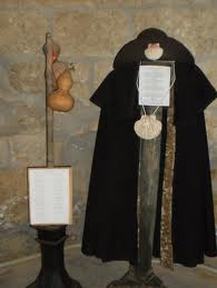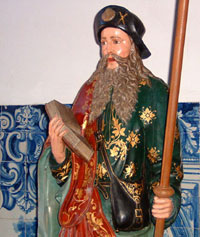
Like others on the Way of St. James, I will be traveling in soft, lightweight clothes, which dry quickly, resist wrinkles, do not retain odor, and have UV protection. Modern attire is quite a departure from the clothes pilgrims wore in the Middle Ages and Renaissance, when any person wearing the official pilgrim’s outfit was exempt from the laws of the country through which he was passing; was judged according to statutes written expressly for pilgrims; and was given free lodging, food, and respect. In fact, King Philip II issued a decree in 1590 which restricted the pilgrim outfit from being worn in Spain outside of the corridor from the Pyrenees Mountains to Santiago de Compostela. Recognizable pilgrim apparel then included a full-length black cape that served as a coat and a blanket; strong boots; a broad-brimmed black hat; a small waist crip; and at least one scallop shell fastened to the cape or hat, or hung around the neck. Instead of trekking with Leki poles and packing stainless steel water bottles, the pilgrim carried a sharpened wooden staff for protection with a gourd tied to it for holding his water. His backpack was made of the “rawhide of a dead beast” because “the pilgrim ought to torment his own depraved lusting flesh with hunger and thirst, with great abstinence, with cold and destitution, with punishment and hard labor.”

Why the scallop shell symbolism? It is believed that, some years after Christ’s crucifixion, St. James sailed to Galicia and ministered to the pagan population there. Having limited success, he returned to Jerusalem where he was beheaded by Herod in 42 A.D. St. James’s disciples brought his body back to be buried at Finis Terre (Worlds End). Queen Lupa conspired with the Roman Legate to destroy St. James’s body as well as those of his disciples. The disciples managed to escape with the bridge over the Tambre River collapsing just after they passed over. Libredon (now Santiago) was not far away, and it was there that they finally laid St. James’s body to rest. Moreover, according to a Finisterre legend, when St. James’s disciples carried his remains from their stone boat, they interrupted a wedding and spooked the groom’s horse, which bolted into the sea where the horse and groom both drowned. St. James’s first European miracle occurred thereafter when the horse and groom rose from the waves, trailing seaweed garlands tangled with scallop shells.
* * *
In addition to scallop shells adorning every pilgrim, the Camino Frances is way marked with flecha amarillo, yellow arrows which very much look like sideways scallop shells.
* * *
In addition to scallop shells adorning every pilgrim, the Camino Frances is way marked with flecha amarillo, yellow arrows which very much look like sideways scallop shells.

 RSS Feed
RSS Feed